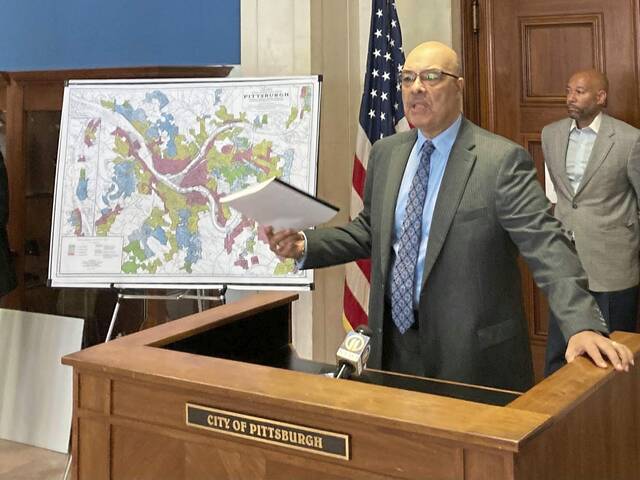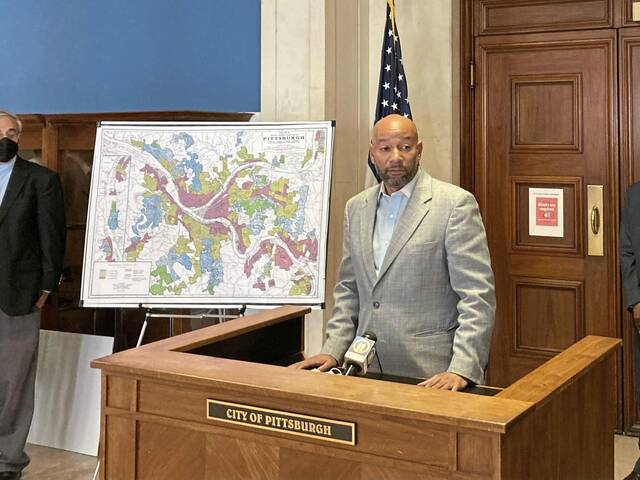Report details lending inequities between Blacks and whites in Pittsburgh
Pittsburgh’s Black residents and those who live in the city’s Black neighborhoods are less likely to get a mortgage for a home than white residents or people who live in white neighborhoods, according to a report released Thursday by city officials.
The 129-page report, “Inherited Inequality: The State of Financing for Affordable Housing in Pittsburgh,” is a landmark study and that proves “greedy institutions are literally starving” Black neighborhoods, Councilman Ricky Burgess said Thursday.
Burgess, Councilman R. Daniel Lavelle and members of two community groups released the report before they discussed it as a council meeting.
The report was completed in partnership with Carnegie Mellon University.
It looks at the racial disparities in home mortgage lending since the 2008 recession.
Burgess said the end result will be gentrification.
Much of the contents of the report was also submitted in February as testimony from the Pittsburgh groups Parents Against Violence and the Lower Marshall-Shadeland Development Initiative to the Board of Governors of the Federal Reserve System.
The lending records of more than 900 banks that made loans in Pittsburgh between 2007 and 2019 were examined in compiling the report. Of $11.8 billion in home mortgage loans issued during that time, 3.5% went to Blacks and 6.8% were approved in Black neighborhoods, the report found.
There were 551 banks that did not make loans to Blacks between 2007 and 2019, and only 14 bank branches are in Black neighborhoods. Blacks hold less than a one-half percent of all branch deposits in the city, something that shows the lack of wealth among Black residents in Pittsburgh, according to the report.
Bankers group replies
The Pennsylvania Bankers Association, a Harrisburg-based trade group of more than 120 banks, is reviewing the report, it said in a statement issued after the report was released.
“Our member banks in the Pittsburgh area are committed to serving all communities. Their business is premised on making as many safe and sound loans to qualified borrowers as possible without regard to race or ethnicity,” the statement reads. “They also face strict legal obligations to comply with the rigorous lending rules put in place after the 2008 financial crisis to protect consumers.”
The association said some borrowers don’t meet ability to repay requirements to qualify for a mortgage.
“We will continue to work with all stakeholders on ways to increase access to credit for those looking to enjoy the many benefits of homeownership,” the association statement said.
Burgess, of North Point Breeze, represents council District 9, which includes East Liberty and Homewood, where 77% of the population is Black or another minority. Banks lent about $451.7 million — 3.8% of the total lent in the city — in his district in the time period covered in the report.
But in council District 8, represented by Erika Strassburger which includes parts of Oakland, Squirrel Hill and Shadyside, banks lent nearly $2.8 billion in the same time period, according to the report. District 8 is 25% Black or minority.
The report shows “redlining,” the practice of not lending to people because of where they live, remains an issue. During the news conference, a 1937 map of the city was displayed that detailed what was called “residential security” that color-coded neighborhoods of the city to show where banks were likely to lend and the red areas where they wouldn’t.
Included in the red areas were the North Side, Hill District, East Liberty, Larimer and Homewood.
The issues those areas faced then remain today, Burgess said.
Burgess and Lavelle have led troves of initiatives and programs to help the Black community over the last decade. But that government-led aid isn’t enough, both said.
“As much of we’ve done, the private market has done little or nothing for those same communities,” Burgess said. “Instead they have put their money into segregated, white, wealthy communities. This report validates in writing, in great detail, this trend.”
Lavelle called the findings of the report “shameful.”
“The disparity in the lending patterns between the Black and white community has only exacerbated the already existing racial inequities that exist in our city,” he said. “It’s so bad, that as of right now, if you’re white and decide to move into a Black community, you will more likely to get a mortgage than if you’re a Black person living in a Black community.”
The report will be posted on the city’s website.
Tom Davidson is a TribLive news editor. He has been a journalist in Western Pennsylvania for more than 25 years. He can be reached at tdavidson@triblive.com.
Remove the ads from your TribLIVE reading experience but still support the journalists who create the content with TribLIVE Ad-Free.



